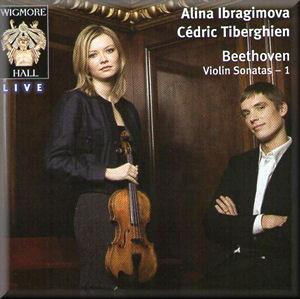 |
 |
|


alternatively
CD: MDT
AmazonUK
AmazonUS
|
Ludwig van
BEETHOVEN (1770-1827)
Violin Sonatas: Volume 1
No. 1 in D, Op. 12/1 (1799) [19:50]; No. 4 in A minor, Op. 23 (1800)
[20:23]; No. 8 in G, Op. 30/3 (1801/2) [17:44]; No. 7 in C minor,
Op. 30/2 (1801/2) [24:27]
 Alina Ibragimova (violin); CÚdric Tiberghien (piano)
Alina Ibragimova (violin); CÚdric Tiberghien (piano)
rec. live, Wigmore Hall, London, 27 October 2009
 WIGMORE HALL LIVE WHLIVE0036 [82:24]
WIGMORE HALL LIVE WHLIVE0036 [82:24] 
|
|
|
On this evidence this is clearly a very special musical partnership.
Ibragimova and Tiberghien have high profile and successful solo
careers. They actually played some of the sonatas together during
their time as Radio 3 New Generation Artists. Later, in October
2009, they embarked on a complete cycle following an Aldeburgh
residency which gave them time to work together on these masterworks.
Here is the concert at the Wigmore from 27 October 2009, as
fresh and invigorating music-making as one is likely to hear.
They begin with the D major, Op. 12/1. Rapid semiquaver runs
hold no fears for either player, and when played together the
ensemble is miraculous. The reading is evidently carefully considered.
The opening’s combination of outgoing D major celebration with
a more intimate mode of utterance sets up a contradiction that
leads to a full flowering of the more ruminative aspect later
in the movement. This sounds perfectly inevitable in these hands.
Ibragimova’s tone is pure and sweet, and she clearly is alive
to the more lyric aspect to this first movement without, laudably,
interrupting the basic pulse. The central variation movement
is, interpretatively, highly exploratory, with the players intent
on fully revealing the music’s many layers. As the emotional
core of the work, it requires a jaunty finale, and that is exactly
what it gets, with the youth of the players working entirely
in their favour here. One sits agape at Tiberghien’s easy evenness
with the accompaniments. The quiet end is miraculously accomplished.
The A minor, Op. 23 receives a serious, pensive account. Ibragimova’s
shifting, nervous lines hit at the very heart of the sonata.
The substitute slow movement, an Andante scherzoso, pi¨ Allegretto,
contains some delicious dialogue between the two instrumentalists.
It is pure joy – one can clearly imagine smiles on the performers’
faces. The confidence from both Ibragimova and Tiberghien of
the opening of Op. 30/3, taken at breakneck speed, is remarkable.
Ibragimova offers some supremely sweet playing here, too. Concentration
reaches its peak in the central movement (Tempo di menuetto,
ma molto moderato e grazioso); the finale is another master-class
in ensemble, shot through with Beethovenian verve.
Finally, the C minor, Op. 30/2 which is given an impetuous reading
of great spontaneity. There is some beautiful stopping from
Ibragimova - as if it is the most natural thing in the world
for her to do. I wonder if Tiberghien could not have made more
of his mid-movement subterranean rattlings, and of the two it
is Ibragimova who better captures the C minor dynamism inherent
in the music. Tiberghien finds the repose of the Adagio cantabile’s
opening, though, preparing superbly for the violin’s entrance.
Ibragimova does not disappoint, whispering sotto voce
into the audience’s ear. The ghostly passage just prior to the
five minute mark here is most effective, especially from Tiberghien
with his disembodied scales. The scherzo and finale are the
essence of Beethoven’s spirit, accents cheeky and disruptive,
gruff outbursts superbly rendered, energy everywhere.
The concert itself was reviewed
by my colleague Mark Berry for this site in the Seen
& Heard section. The steeliness of tone from Ibragimova
at the outset of Op. 12/1 noted there seems far less intrusive
on disc; I wonder whether this was an acoustic problem? Reviewer
seats at the Wigmore are usually right at the back, right in
the acoustic trap, whereas the microphones are inevitably far
closer to the musicians. Or, could it have been retaken after
the concert? In support of such tidying-ups taking place, Mark
noted that the final bars of Op. 30/2’s slow movement degenerated
into a coughathon, but there is no sonic evidence of that here.
The Wigmore Hall Live label has opted to print some details
in black against a purple background, making them difficult
to read. A shame, as these are vibrant readings whose sense
of life is infectious. It would be a pity if that put off prospective
purchasers in record shops - if anyone goes to them, these days.
The playing time, at over 80 minutes, is massively generous,
too.
Colin Clarke
|
|
|

